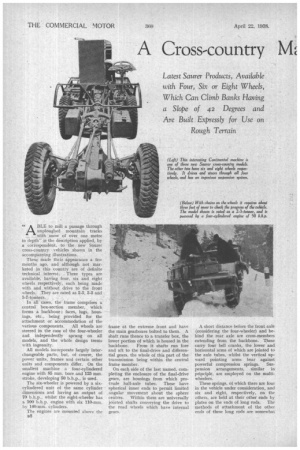A Cross-country Ivli hine of Marked Capabilities
Page 42

Page 43

If you've noticed an error in this article please click here to report it so we can fix it.
" ABLE to mill a passage through
unploughed mountain tracks with snow of over one metre in depth'' is the description applied, by a correspondent, to the new Saurer cross-country vehicles shown in the accompanying illustrations.
These made their appearance a few months. ago, and although not marketed in this country are of definite technical interest. Three types are available, having four, six and eight wheels respectively, each being made with and without drive to the front wheels. They are rated as 2-3, 3-5 and 5-77tonners.
In all cases, the frame comprises a central box-section member, which forms a backbone ; faces, lugs, housings, etc., being provided for the attachment or accommodation of the various components. All wheels are steered in the case of the four-wheeler and independently sprung on all models, and the whole design teems with ingenuity.
All models incorporate largely interchangeable parts, but, of course, the power units, frames and certain other units and components differ. On the smallest machine a four-cylindered engine with 85 mm. bore and 125 mm. stroke, developing 50 b.h.p., is used.
The six-wheeler is powered by a sixcylindered unit of the same cylinder dimensions and having an output of 70 b.h.p., whilst the eight-wheeler has a 140 b.h.p. engine with six 110-mm. by 140-mm. cylinders.
The engines are mounted above the frame at the extreme front and have the main gearboxes bolted to them. A shaft runs thence to a transfer box, the lower portion of which is housed in the backbone. From it shafts run fore and aft to the final-drive and differential gears, the whole of this part of the transmission being within the central frame member.
On each side of the last named, completing the enclosure of the final-drive gears, are housings from which protrude hall-axle tubes. These have spherical inner ends to permit limited . angular movement about the sphere centres. Within them are universally jointed shafts conveying the drive to the road wheels which have internal gears. A short distance before the front axle (considering the four-wheeler) and behind the roar axle are cross-members extending from the backbone. These carry four hell cranks, the lower and horizontal arms of which are jointed to the axle tubes, whilst the vertical upward pointing arms bear against powerful compression springs. Suspension .arrangements, similar in principle, are employed on the multiwheelers.
These springs, of which there are four in the vehicle under consideration, and six and eight, respectively, on the others, are held at their other ends by plates on the ends of long rods. The methods of attachment of the other ends of these long rods are somewhat
different on the various models.
Where each pair of rods takes the weight supported by one axle, they are secured to the frame, but where they share the weight carried by two axles they run direct from one pair of springs to the other. By this means pressure between the wheels is equalized ; when one is caused to rise by a ground irregularity there is a corresponding tendency for the other to fall.
The arrangement gives the vehicles remarkable wheel articulation,each. being capable of a vertical disPlacement arnounting to abont. 18 ins. At its outer end, each 'axle of the tour-wheeler and eack'of the two front axles of the eight-Wheeler Is forked 'tó carry a two-piece swivel pin, the stub axle. being similarly constructed. Between the two partsof the pin is the wide-angle universal joint of the driving shaft.
With regard to the steering linkage drag link from the orthodox steering box is coupled to one front-steering arm. Thence a long rod runs to a suitably set lever running across the frame at about the centre. The other end of this is coupled to the other frontsteering arm. A relay mechanism, disposed amidships, transfers the movement of the trangverse lever to a second similar lever whiCh 'oPerates, via further rods, the rear-wheel. steering arms. Provision is made for disconnecting and locking the rear steering gear at will.
One of our illustrations shows the general construction of the chassis and the others give a good impression of its capabilities under extremely arduous cOnclitions. . A noteworthy point is the stability of the .vehicle, its level being affected only moderately by extreme displacements Of the wheels. Also of note is the relatively large body space available, this being little interrupted by parts of the mechanism. • .
It is claimed that the vehicle, .has a belly clearance" represented a radius of about 5 ft. arid, that it can negotiate ramps at in angle of 42 degrees to the horizontal. "


































































































